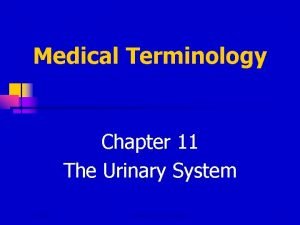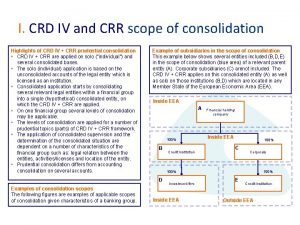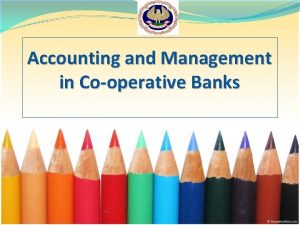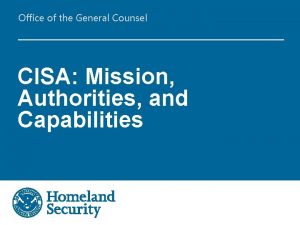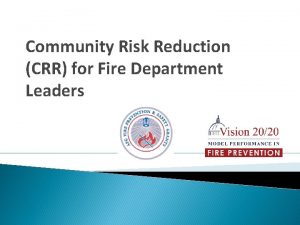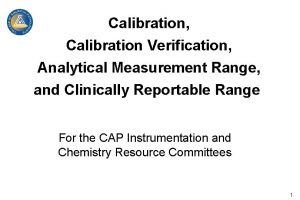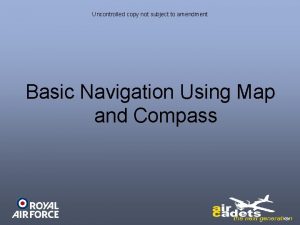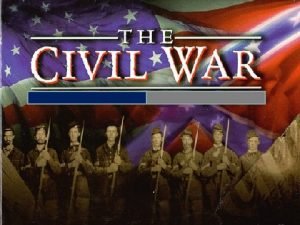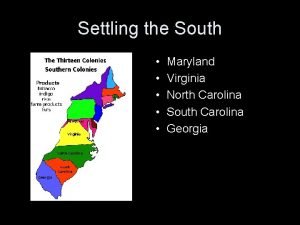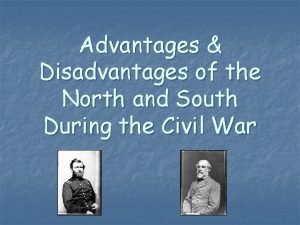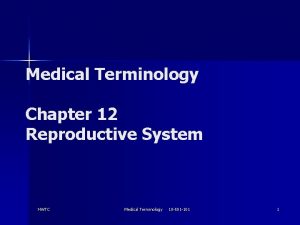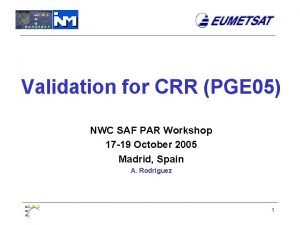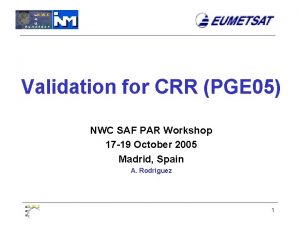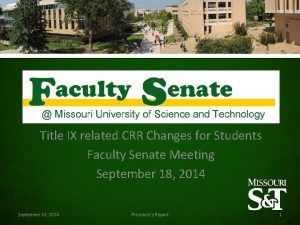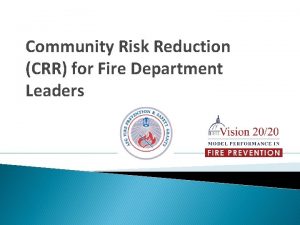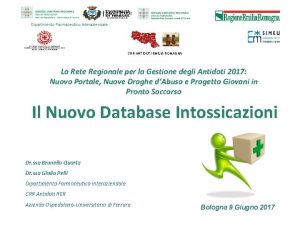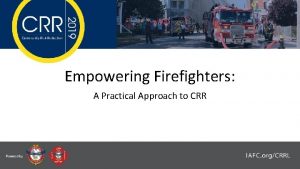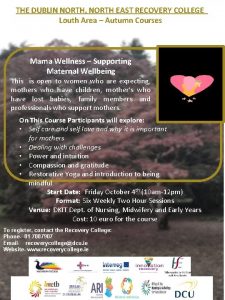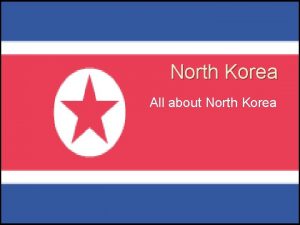CRR the NWTC and the north of the
































- Slides: 32

CRR, the NWTC, and the north of the network What we know, and what we can deduce

What information we currently have • The ‘Request for Project Change’ (Rf. PC) events for CRR have required the publication of the infrastructure layouts – from these we can deduce the rail operations • The BCC NWTN (N for network) community consultation – this lays out the rail options that are available for the NWTC, including how it connects to the network • Rail service plans from CRRDA

The Cross River Rail information • The infrastructure layouts have changed between Rf. PC 4 and Rf. PC 9 • The Rf. PC 4, which was the first of the ‘new era’ and the main change required for EIS approval, had a very basic track layout that facilitated the northern Mains into CRR, the northern Subs in the city Mains, and Ferny Grove into the city Subs • Rf. PC 9 has some additional trackwork that enables different movements, however this doesn’t preclude the Rf. PC 4 assumption

The Cross River Rail information • The major deficiencies with the inferred operating plan are that the growth corridors – Kippa-Ring, Caboolture, Nambour, and any future spur towards Caloundra – end up with no additional paths compared to the current layout with ETCS 2 – 24 tph in total • The constrained group of Shorncliffe, Doomben, and Airport gain access to a 24 tph corridor, running only 14 tph • Ferny Grove gets exclusive access to the highest capacity corridor, capable of 24 tph (or more), while running only 8 tph

The Cross River Rail information • Assuming there has been discussion between the BCC and TMR/CRRDA planners, the NWTN release provides insight that the assumed operating plan for CRR must be correct • In previous operating plans (including the 2017 business case), there would be no room to run services onto the Ferny Grove line, as the city Subs were at saturation point • In the current assumed operating plans, there are notionally (at least) 16 train paths per hour available on the city Subs via the Ferny Grove line

Nambour Caloundra Assumed CRR operations Caboolture Kippa-Ring • The CRR sector (shown in blue) is effectively fully utilised by day one Shorncliffe • The city Mains sector (shown in orange) has spare capacity, but is fed by single track corridors (Airport and Doomben), and a relatively low growth line (Shorncliffe) Airport Doomben Ferny Grove • The city Subs sector (green) is used only by the Ferny Grove line, which is low growth and largely mature as a corridor 24/24 14/24 8/24+

The NWTN information • The rail plans for the NWTN depict, as one option, a two track corridor between Strathpine and Alderley, followed by a ‘future rail tunnel’ to Cross River Rail “in the long-term” • It also shows, as a second option, two new rail tracks in the corridor between Strathpine and Albion – this is subject to only a cursory assessment towards the end of this document

The NWTN information • It is clear that there is an expectation for the services on the NWTC, at least initially, to operate via the Ferny Grove line into the city Subs • Any future connection to CRR would change the routing of at least some of these trains – it is possible that all NWTC trains would continue to CRR, or simply that some would and others would stay on the Ferny Grove line via the city Subs

Possible future states • It is worthwhile understanding the ways in which the proposed network could operate with the infrastructure in place • A key question will be how the capacity from the Northern Growth Group (Kippa-Ring, Caboolture, Nambour, and Caloundra; the “NGG”) can be catered for, and the relative speed of services • A second question will be how the NWTC can be used, including the provision of local services

Possible future states • The most obvious way of using the capacity on the NWTC at day one is to divert trains from the North Coast • Up to 16 tph could be provided, to any of the NGG destinations, increasing their total capacity from 24 tph to 40 tph • Diverting trains from Kippa-Ring would require one of the other groups of services to provide the stopping function between Strathpine and Northgate, which would slow the express services down. However, whichever services run via the NWTC will have the slow Ferny Grove line to contend with, increasing travel time overall

Possible future states • It takes 18 minutes from Alderley to Roma Street, while a journey on the NWTC between Strathpine and Alderley could be expected to take somewhere between 8 -13 minutes, depending on number of stations and alignment speed, for a total journey time of 26 -31 minutes from Strathpine to Roma Street • A journey on the current alignment running express, then into CRR, would likely take under 25 minutes (the current TT is 26 minutes between Petrie and Bowen Hills), so it is unlikely that routing North Coast trains via the NWTC and Ferny Grove would result in travel time savings, and instead increase the travel time

Possible future states • This leads to two possible broad variations with this paradigm • Scenario A sees the Kippa-Ring trains travel via the NWTC, with the rest of the NGG via the existing alignment and CRR • Scenario B sees Kippa-Ring routed via the existing alignment, with the rest of the NGG via the NWTC

Nambour Caloundra Scenario A – day one Caboolture Kippa-Ring • With Kippa-Ring via the NWTC, it is likely that the city Subs would again be nearing capacity (based on the 18 trains in 2036 from Kippa-Ring in the 2017 business case for CRR) • Additional trains would be required to provide the stopping functionality between Strathpine and Northgate, which could be new “Strathpine” starting services, although these would require a significant stabling facility nearby to operate – but would keep the North Coast line services running express Shorncliffe ≤ 16 Airport Doomben Ferny Grove ≤ 24/24 14/24 24/24+

Scenario A – day one • The Kippa-Ring services would likely stop at all-stations along the NWTC and Ferny Grove line, and would still be slightly faster than the current journey to Roma Street • The three track corridor between Strathpine and Northgate would allow up to 24 tph to run a mix of express and all-stations, preserving travel times from Caboolture et al if a supplementary all-stations service was included – which could take the form of Strathpine starters, or a second Caboolture tier of trains, for example

Scenario A – future state • Where Scenario A becomes complicated is if the ‘future tunnel’ to Cross River Rail is ever developed • At this point, the sum of services from the NWTC and those from the Mains north of Northgate (the NGG) must total 24 tph • In our original example, if 16 tph were operating on the NWTC, this would leave only 8 tph to operate from the NGG

Scenario A – future state • Further, unless additional tracks are built from Alderley, any trains from the NWTC that enter CRR similarly reduce the capacity into the city Subs – in our example, this would reduce their usage back to 8 tph • This would again revert the total capacity through the city to the same as day one of CRR – with 24 tph via CRR, 8 tph via the city Subs, and 14 tph via the city Mains – unless significant additional track capacity was provided

Nambour Caloundra Scenario A – future state Caboolture Kippa-Ring • The Kippa-Ring trains via the NWTC re-join the CRR tunnel, displacing the NGG trains that otherwise would have used the CRR tunnel, and limiting the use of the city Subs • Clearly this paradigm is untenable, but even a reduction in the use of the NWTC – and a commensurate increase via the northern Mains – would not provide sufficient capacity, and indeed be a reduction in service compared to today Shorncliffe 16 Airport 8 Ferny Grove Doomben 8 24/24 14/24 8/24+

Scenario A – future state • The capacity issue on the Ferny Grove line and the city Subs could be resolved by quad tracking, allowing an increase in the number of Ferny Grove services (assuming there is any demand), as well as an increase in the NWTC services • It could be possible, for example, to operate 24 tph via the NWTC, and have 16 tph go via the city Subs, and the remaining 8 tph go to CRR, allowing for up to 16 tph from the NGG, however even this is still a reduction in the total capacity compared to today

Scenario A – future state • To fully saturate all corridors, quad track between Alderley and CRR would be required, as would a reorganisation of the tracks through the city • Running up to 24 tph via the NWTC into CRR would be possible in this configuration, while a further 24 tph could be run from the NGG into the city Mains. This would leave the city Subs to host the relatively low demand lines of Ferny Grove, Shorncliffe, the Airport, and Doomben – exactly as they do currently

Nambour Caloundra Scenario A – future state Caboolture Kippa-Ring • In this configuration, the NWTC to Kippa-Ring is an extension of CRR, allowing 24 tph to serve the corridor Shorncliffe • The rest of the NGG has capacity for up to 24 tph, with express times the same as currently 24 Airport Doomben Ferny Grove • However, this would preclude 9 -car train operation through CRR, as the Kippa-Ring line and its stabling are designed for 6 -car operation only 24/24+

Scenario A – future state • It is clear that while this presents a viable way forward in terms of maximising capacity, it does very little to improve travel times from the NGG, with Caboolture and Nambour limited to the travel times of today • It also precludes (effectively) the use of the 9 -car trains that CRR is supposedly designed for, as Kippa-Ring infrastructure is designed for 6 -cars and would be extremely challenging and expensive to extend • The disruption to provide four tracks on the Ferny Grove line should not be underestimated either, as it would be a significant endeavour

Nambour Caloundra Scenario B – day one Caboolture Kippa-Ring • Scenario B provides a more sensible allocation of services to the Mains between Strathpine and Albion, with Kippa-Ring services providing allstations services as per today (with the ability to operate some express via the middle road) • There is the prospect of a moderate increase (from 12 tph to 16 tph) for the rest of the NGG, although they will have a much slower journey time through using the Ferny Grove line Shorncliffe ≤ 16 Airport Doomben Ferny Grove ≤ 24/24 14/24 24/24+

Scenario B – future state • Much of the same argument holds true in Scenario B as per Scenario A, in terms of the cannibalisation of capacity once NWTC trains are diverted into CRR • Ultimately, it ends up with a similar configuration as per Scenario A, with the NWTC becoming a dedicated extension of CRR, and the city Mains and Subs reverting to their current routings

Nambour Caloundra Scenario B – future state Caboolture Kippa-Ring • The NWTC becomes a dedicated extension of CRR to Caboolture, Nambour, and Caloundra, allowing the use of 9 -car trains, and providing a moderate improvement to run times from these locations Shorncliffe Airport • The Kippa-Ring line runs through the city Mains, with the opportunity to have some express running between Strathpine and Northgate using the middle road Doomben Ferny Grove 24/24+

Scenario B – future state • Depending on the number of additional stations on the NWTC, the travel time for the Caboolture et al services could be significantly improved (no stations) or only marginally improved (several stations) • If a high station density was desired, a third track would be required to separate express services in the peak direction • Given the configuration the network ends up in, a fourth track does not seem to be meritorious as there would be sufficient capacity in the off and contra-peak to maintain decent express running

Possible future states – other configurations • It is possible to consider a Scenario A where the tunnel to CRR is never constructed, which results in a relatively high utilisation of most lines – 16 tph on the NWTC, 24 tph via CRR, 24 tph via the city Subs, although still only 14 tph on the city Mains • Given that there is no allowance for a connection to CRR in the CRR plans (which would be required, lest a significant shutdown – lasting months – be undertaken to tie the new tracks in), it could be that the configuration depicted in “Scenario A day one” is the de facto end state assumption for the network • Future states which involve mixing the NWTC and the northern Mains, and the northern Mains and the city Mains, are too complicated, and would need a minimum of a fourth track between Strathpine and Northgate to complete sectorisation (and still would result in underutilised track assets)

The “other one” – two additional tracks between Strathpine and Albion • From a conceptual perspective, building an additional two tracks between Strathpine and Albion would ultimately end up with the same configuration as Scenario B future state – with Caboolture et al via CRR, Kippa-Ring via the city Mains, and the rest via the city Subs • Indeed, it isn’t clear why simply a fourth track between Petrie/Lawnton and Northgate, and thereafter a second track pair to Albion isn’t the recommendation here, as this would allow the same segregation of services, albeit without the ability for Kippa-Ring trains to run express

Nambour Caloundra Caboolture Kippa-Ring Shorncliffe Airport Doomben Ferny Grove 24/24+ Scenario B – future state Airport Doomben Ferny Grove 24/24+ The other one

Possible future states – “fast rail” corridor • The mystery option in all these configurations is the “fast rail” corridor, which could take some of Nambour/Caloundra trains away from the network on a dedicated corridor • While this would address some of the travel time issues, it would not change the problems resulting from the network configuration under either scenario • Additionally, pinning one’s hopes on a completely segregated corridor the best part of 100 km in length, including a new terminus or line in the city, would be “optimistic” given how poorly CRR is being delivered

Exhibition station • It is not clear from the drawings whether the future tunnel would take in the Exhibition station, but it appears not • This would leave the Exhibition station unserved in any configuration which did not have trains coming to CRR from the northern Mains, unless a shuttle between Roma Street and Exhibition was operated • Nevertheless, it is not considered critical to the point of designing the entire network operation around this single station

Summary • While this analysis is not completely exhaustive, it does cover off the reasonable broad approaches that could be taken, based on the information currently available • It appears that there is no viable long term plan for the network, with every configuration either wasting capacity, requiring reconfiguration of the network unnecessarily, slowing travel times, or some combination of the above

Summary • It is not clear whether two, three, or four tracks are required in the NWTC, although any of the previously described scenarios would be unlikely to benefit from more than three • The lack of an overarching rail network strategy means it is impossible to determine the appropriate form for rail in the NWTC, what function it should provide, and how the network – including Cross River Rail – should develop over time • The disparate nature of the planning agencies is a further cause for concern
 Nephrosonography medical term
Nephrosonography medical term I crd
I crd Credit control instruments of rbi
Credit control instruments of rbi Crr for cooperative banks
Crr for cooperative banks Cisa csd org chart
Cisa csd org chart Apa itu cost recovery
Apa itu cost recovery Crr plan
Crr plan Calibration verification linearity
Calibration verification linearity Investopedia inflation
Investopedia inflation Integrated care system north east
Integrated care system north east Lesson quiz 14-1 north and south
Lesson quiz 14-1 north and south True north vs magnetic north
True north vs magnetic north The north pole ____ a latitude of 90 degrees north
The north pole ____ a latitude of 90 degrees north Anaconda plan
Anaconda plan Imaginary lines of the earth
Imaginary lines of the earth Virginia, maryland, north carolina, south carolina, georgia
Virginia, maryland, north carolina, south carolina, georgia North and south advantages and disadvantages
North and south advantages and disadvantages North and south strengths and weaknesses chart
North and south strengths and weaknesses chart Hát kết hợp bộ gõ cơ thể
Hát kết hợp bộ gõ cơ thể Slidetodoc
Slidetodoc Bổ thể
Bổ thể Tỉ lệ cơ thể trẻ em
Tỉ lệ cơ thể trẻ em Voi kéo gỗ như thế nào
Voi kéo gỗ như thế nào Tư thế worm breton
Tư thế worm breton Bài hát chúa yêu trần thế alleluia
Bài hát chúa yêu trần thế alleluia Các môn thể thao bắt đầu bằng tiếng bóng
Các môn thể thao bắt đầu bằng tiếng bóng Thế nào là hệ số cao nhất
Thế nào là hệ số cao nhất Các châu lục và đại dương trên thế giới
Các châu lục và đại dương trên thế giới Cong thức tính động năng
Cong thức tính động năng Trời xanh đây là của chúng ta thể thơ
Trời xanh đây là của chúng ta thể thơ Cách giải mật thư tọa độ
Cách giải mật thư tọa độ Phép trừ bù
Phép trừ bù Phản ứng thế ankan
Phản ứng thế ankan
